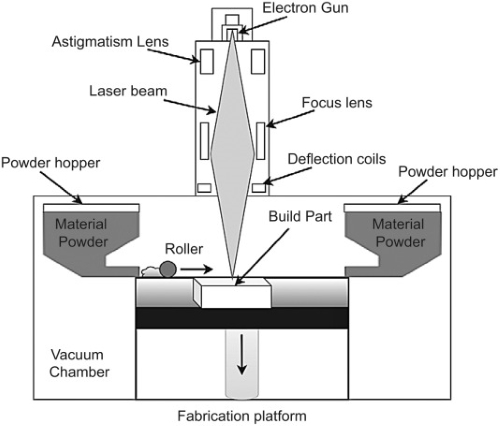
Refractory metals are essential in demanding industrial applications such as aerospace, electronics, and energy production. However, processing these metals presents significant challenges due to their high melting temperatures and resistance to deformation. Two primary methods are used to process refractory metals: melting and powder metallurgy. Each method offers unique advantages and is suited to specific applications.
Melting refractory metals requires specialized techniques to overcome their extreme melting points, which can exceed 3,400°C in the case of tungsten. Conventional melting processes are inadequate for such materials, leading to the development of advanced techniques that provide the necessary heat and control. The following are key melting methods used for processing refractory metals:
Related reading: All You Need to Know about Refractory Metals
Electron Beam Melting involves directing a high-energy electron beam onto the metal in a vacuum environment, which allows the material to reach its melting point without oxidation or contamination. This method is highly effective for materials like tungsten and tantalum, where maintaining purity is critical. The vacuum environment prevents unwanted reactions, and the electron beam allows for precise temperature control, making EBM ideal for producing high-purity ingots or complex shapes.
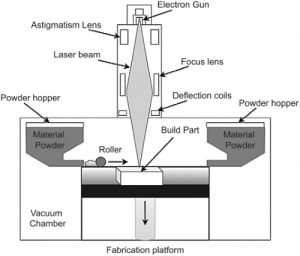 [1]
[1]
In arc melting, an electric arc is generated between the metal and a non-consumable electrode, creating intense heat. The process can be conducted in a vacuum or an inert gas atmosphere to prevent oxidation. Arc melting is commonly used for metals like tantalum and molybdenum, and it is particularly suitable for producing large ingots. This method is favored for its ability to quickly melt and alloy metals, which are later machined into final components.
Plasma Arc Melting utilizes a plasma torch to achieve the high temperatures needed to melt refractory metals. The plasma is generated by electrically charging a gas, which then heats the metal to its melting point. PAM is particularly useful for processing metals like niobium and tantalum, offering fine control over the process and ensuring minimal contamination.
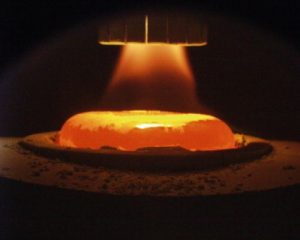 [2]
[2]
Induction melting uses an alternating magnetic field to heat the metal via electromagnetic induction. This process is more commonly applied to smaller quantities of refractory metals. Induction melting offers good temperature control, but it is typically used in conjunction with other methods for high-performance applications where purity and precision are critical.
Melting methods are used when large, dense ingots are required or when the material needs to be cast into complex shapes. However, due to the difficulty in controlling the melting of refractory metals and the risk of contamination, alternative methods like powder metallurgy are often preferred.
Powder metallurgy is a widely used method for processing refractory metals, offering several advantages over melting. It involves compacting metal powders into a desired shape and then sintering the part to form a solid structure. This process eliminates the need to fully melt the metal, making it ideal for materials with extremely high melting points. Powder metallurgy is particularly well-suited for producing high-performance components with complex geometries and precise dimensions.
The first step in powder metallurgy is the production of metal powders. Refractory metal powders can be made using various methods, including chemical reduction, mechanical grinding, and atomization. For example, tungsten powder is commonly produced by reducing tungsten oxide with hydrogen gas. The resulting powder must have uniform particle size and high purity to ensure consistent properties in the final part.
The metal powder is then compacted into the desired shape using a die. High pressure is applied to create a dense “green” compact. The density and uniformity of this compact are critical to the performance of the final part. The compaction process can be adjusted to meet specific requirements, such as creating parts with graded density for specific applications.
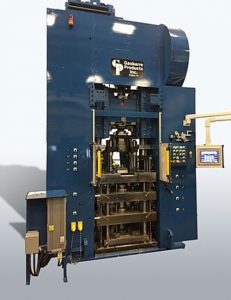 [3]
[3]
The green compact is heated in a controlled atmosphere, typically in a vacuum or inert gas, to a temperature just below the metal’s melting point. This process, called sintering, causes the powder particles to bond together without fully melting. Sintering results in a strong, dense part with good mechanical properties. The sintering temperature and duration are carefully controlled to optimize the material’s microstructure.
In some cases, Hot Isostatic Pressing (HIP) is used to further densify the sintered part. HIP involves placing the part in a high-pressure, high-temperature environment to eliminate porosity and improve mechanical properties. This step is often used for critical components that must withstand extreme conditions, such as turbine blades or nuclear reactor components.
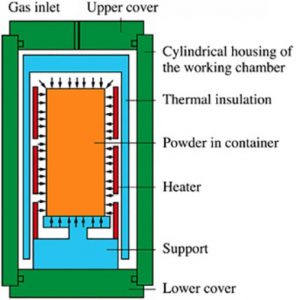 [4]
[4]
After sintering, the part may undergo secondary operations such as machining, grinding, or coating to achieve precise dimensions and surface finishes. Powder metallurgy is highly adaptable, allowing for the production of parts with intricate shapes and minimal material waste. This method is commonly used in industries where efficiency and precision are paramount, such as aerospace, electronics, and medical devices.
While both melting and powder metallurgy are used to process refractory metals, each method has its strengths. Melting is typically employed for large-scale production of metal ingots or when precise alloying is required. On the other hand, powder metallurgy is preferred for manufacturing complex shapes and achieving fine microstructural control.
Both melting and powder metallurgy offer effective solutions for processing refractory metals. Melting is preferred for producing large ingots or castings, while powder metallurgy is widely used for complex parts that require precision and high performance. As industries continue to push the boundaries of what materials can do, these processing methods will remain essential to harnessing the full potential of refractory metals. For more information, please check Advanced Refractory Metals (ARM).
Reference:
[1] Saleem Hashmi (2024). Comprehensive Materials Processing. Elsevier. https://www.sciencedirect.com/referencework/9780323960212/comprehensive-materials-processing
[2] Zetian Mi, Hark Hoe Tan (2024). Semiconductors and Semimetals. Academic Press.https://www.sciencedirect.com/bookseries/semiconductors-and-semimetals
[3] Powder metallurgy. (2024, September 22). In Wikipedia. https://en.wikipedia.org/wiki/Powder_metallurgy
[4] G.S. Hikku, C. Arthi, R.B. Jeen Robert, K. Jeyasubramanian, R. Murugesan, Calcium phosphate conversion technique: A versatile route to develop corrosion resistant hydroxyapatite coating over Mg/Mg alloys based implants, Journal of Magnesium and Alloys, Volume 10, Issue 7, 2022, Pages 1821-1845, ISSN 2213-9567, https://www.sciencedirect.com/science/article/pii/S2213956722001578
Copyright © 1994-2024 Advanced Refractory Metals owned by Oceania International LLC, All Rights Reserved.